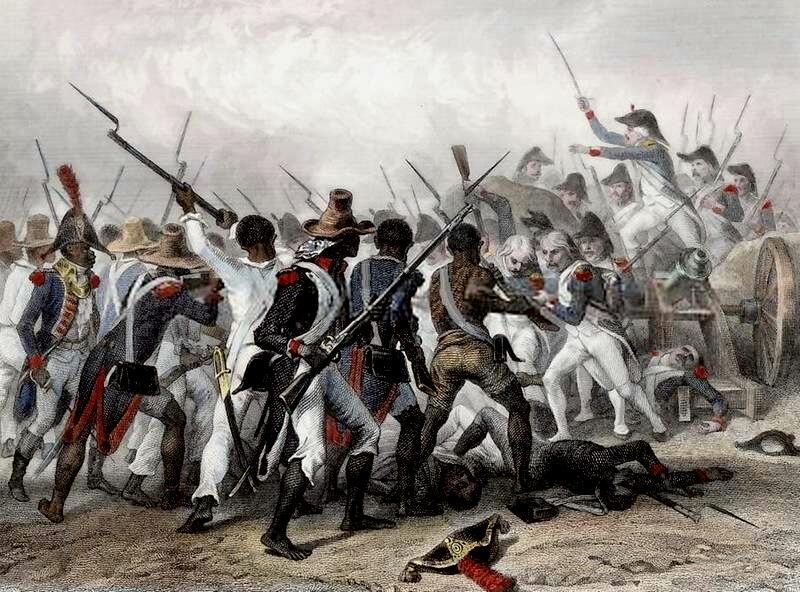
Haitian History: War for Independence--Napoleonic Campaign (1801-03)

Figure 1.--Napoleon sent a massive army to retake Saint Domingue and restore slavery. He badly needed funds and Saint Domingue before the kave rebellion had generated huge earings from sugar and other imports. At first the Haitins avoided battle, but as disease devestated the French Army, Gen. Dessalines who replaced L'Ouverture began to pursue an offensive campaign and score victories. The last battle was fought at Vertières (November 1803). French General Rochambeau surrendered, but was allowed to embark the survivors and leave Haiti to the Hatians. We are not sure who the artist here was and when it was painted.
|
|
Napoleon Bonaparte dispached a huge fleet and military force to seized control of Haiti. Napoleon saw the restoration of slavery and the return of Saint-Domingue to French control as important. Here he was concerned with the sugar exports that had once provided enormous earning to France. He also envisioned a renewed French empire in North America and had acquired Louisiana back from Spain. He provided his brother-in-law--Charles Leclerc, a well equipped Army of 82,000 men for the Cribbean/Louisana cmpsign. This was a huge army, an amazing force to subdue slaves on a single island. It was in fact, incredibly larger than the armies Britain deployed in the American colonies during the Revolutionary War--despite the relatively small size of St. Dominique compared to the American colonies. Historians speculate as to Napoleon's objectives. It seems likely that after restoring order in Saint Dominique, the army would have been redeployed in Louisana to restablish the French presence in North America. It would have posed a major challenge on the western frontier of the new United States. It would have meant that rather than a wak Spain, the United States would find a powerful French Army on its western border.The French arrived in a fleet of warships with canons, munitions and even dogs. President Jefferson followed developments carefully. The United States was not going to recognize a slave republic, but id not stop supplies from reaching the rebels. Leclerc used a ruse to capture L'Ouverture (June 1802). He was deported to France and died in the Fortress of the Joux in the Alpine mountains of Jura as a result of the cold and starvation ordered by Napoleon (April 1803). The Haitians did not have the men or arms needed to defeat the French Army.
The French failed, however, proved unable to defeat the rebels. A major factor here was disease. The French troops were devestated by tropical diseases. The troops, embued with the ideals of the Revolution, were shocked to learn tht their mission was to renslave the population. The Convention in Paris reintroduced slavery to Saint Domingue (1802). This resulted in a renewed rebellion and more massacres (1802). Leclerc did not live much longer than L'Ouverture. He died of yellow fever (November 1802). Napoleon replaced him with Donatien-Marie-Joseph de Vimeur, vicomte de Rochambeau, the son of the French Marshal Rochambeau who played a key role in the American Revolution. He proved as brutal as Leclerc. The slaves continued to resist even after Toussaint's capture. Within only 6 months, 24,000 French soldiers had died. Some French soldiers even went over to the slaves who became known as Black Jacobins. This was particularly the case for a contingent of Polish troops. The massive French force was descimated and Napoleon manage to achieve only a stalemate. L'Ouverture's capable generals carried on the struggle. Dessalines emerged as the new leader of the Haitian resistance. Other important leaders were Alexandre Petion, François Capois named "La Mort", Henri Christophe, and Boironds Tonnerre. The slave leaders realized that they did not have to dfeat the French army, only outlast them. And here disease (yellow feaver) took a deadly toll. Asthe size of the French Army dclined, Dessalines took the offensive and defeated the French army numerous times. The final battle was at Vertières along the northern coast (November 17-18, 1803). Dessalines during the night positioned their few guns to blast Fort Bréda, located on the habitation where L'Ouverture had worked as a coachman. Adm Rochambeau was watching from the rampart of Vertières as anoher Haitian victory unfolded. Rochambeau negotiated a surender with Dessalines. Rochambeau was given 10 days to embark what was left of the French Army and leave Saint-Domingue. Wounded French soldiers had to be left behind. The Hitians drowned them a few days later. [Popkin. p. 137.] Shortly after the departure of the French, Dessalines' proclaimed independence and a Haitin Reopublic (January 1, 1804). With the French finally withdrawl, the Haitians had achieved the first successful slave rebellion in history. This military disaster in Haiti was a major factor in Napoleon's decission to sell Louisiana to the Americans. The United States andc France signed the Louisiana Purchase Treaty while fighing was still going on in Haiti (April 30, 1803).
Sources
Popkin, Jeremy D. A Concise History of the Haitian Revolution (Chichester, West Sussex: Wiley-Blackwell, 2012).
CIH

Navigate the Children in History Website:
[Return to the Main Haitian independence page]
[Return to the Main Haitain history page]
[Return to the Main French slavery page]
[Return to the Main French Revolution and slavery page]
[Return to the Main Latin American wars of independence page]
[Return to the Ending the Atlantic slave trade]
[Introduction]
[Animals]
[Biographies]
[Chronology]
[Climatology]
[Clothing]
[Disease and Health]
[Economics]
[Ethnicity]
[Geography]
[History]
[Human Nature]
[Law]
[Nationalism]
[Presidents]
[Religion]
[Royalty]
[Science]
[Social Class]
[Bibliographies]
[Contributions]
[FAQs]
[Glossaries]
[Images]
[Links]
[Registration]
[Tools]
[Children in History Home]
Created: 4:05 AM 7/10/2018
Last updated: 4:05 AM 7/10/2018



